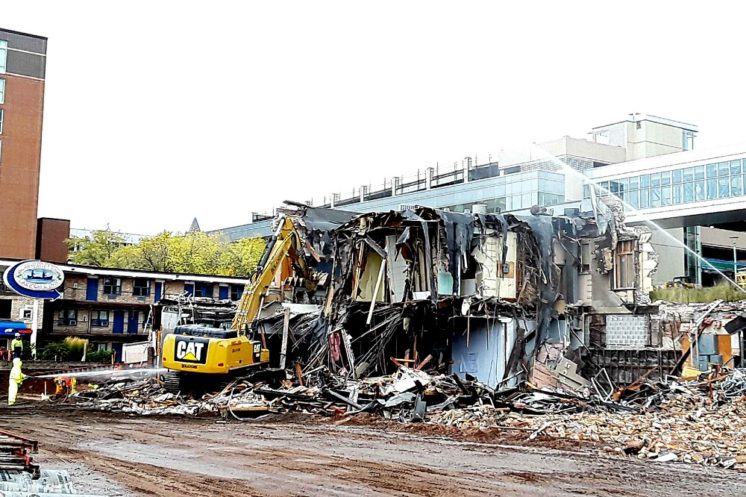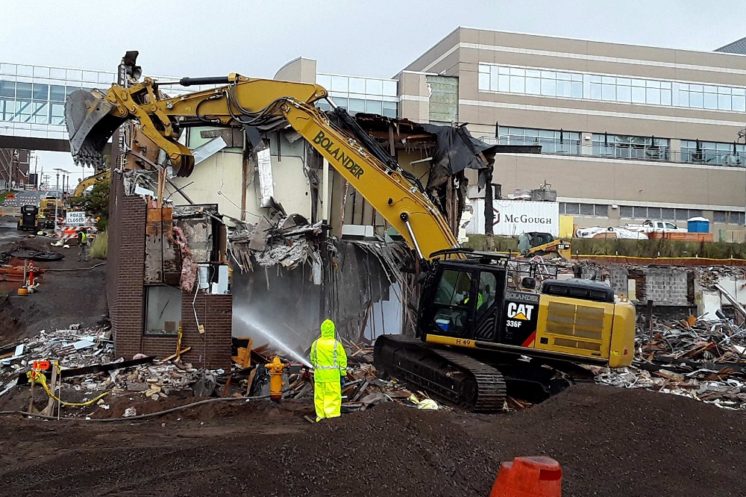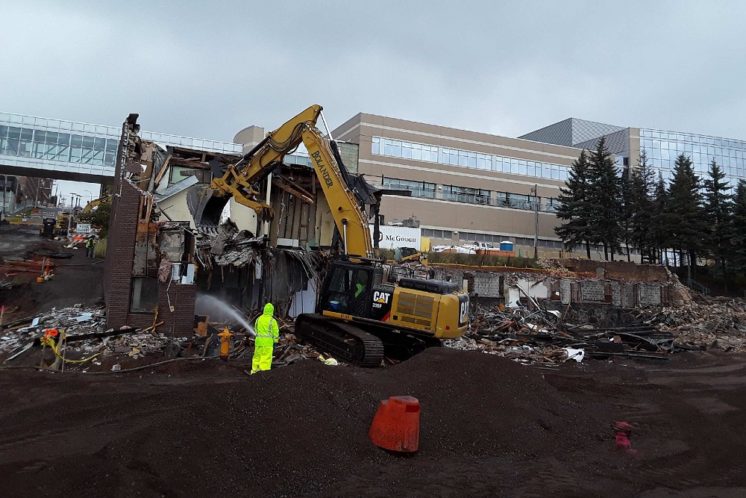R.I.P. Amendola Building
The Amendola Building at 405 E. Superior St. was demolished today to make way for Essentia Health’s Vision Northland project.
Here is some background on the Amendola building from a 2014 document titled Historic Resources Inventory for the East End Residential Area-Phase V.
Resource # 177. Dodge Block (Amendola Building), 405 E. Superior Street (SL-DUL-0818) This two-story flat-roofed broadfront commercial building has a concrete foundation and walls clad in brick. The Superior Street façade is divided into eight bays. The primary entrance spans the two central bays and has a flat-roofed canopy. Modern steel and glass commercial doors are recessed. Windows throughout the building have been replaced, as has most of the brick cladding on the building. The entire first floor façade had been altered at the time of its initial inventory in 1980. Since then, further remodeling has occurred, including alterations to the arcade between the floors and the second floor windows. The arcade is clad in painted cement board panels. According to the 1950 Sanborn map, there was no cutaway corner at the 4th Avenue and Superior Street intersection, but it is not clear when that alteration occurred.
The Dodge Block was constructed in 1911, and R. M. Hunter & Co. were the real estate agents in charge of renting out the building’s retail and office space. Eight storefronts spanned the first floor along Superior Street. The upper floors were used for professional offices and services including milliners and tailors. In 1913, Henrik Holmboe began operating his wallpaper studio, office and showroom from a storefront. Flaaten’s Conservatory of Music was a longtime tenant in the building. According to the 1950 Sanborn map, the two storefronts at N. 4th Avenue E. and E. Superior Street were used by a restaurant while the remaining six were used as stores.
This property was initially inventoried in 1980 as a part of the St. Louis County Historical Society “Duluth’s Eastern CBD Area” survey and was included in the 1984 citywide Duluth Historic Resources Survey. At the time, it was categorized under Group III Commercial, defined as “More common structures and related cultural resources that contribute to the overall character of Duluth. Although most Group III buildings would probably not qualify for listing in the National Register of Historic Places, they are worth of preservation whenever feasible. Owners should be made aware of their value and encouraged not to destroy the architectural integrity and character of such structures through senseless remodeling and ‘modernization’ schemes.” No recommendation of eligibility was made.
This property has been extensively altered including replacement brick cladding, replacement windows, and the cutaway corner at 4th Avenue and Superior Street. These alterations have compromised the integrity of materials, design, workmanship, and feeling, and the building cannot convey any possible historic significance. For this reason, the property is recommended not eligible for listing in the NRHP or for local designation by the City.
Recommended Links:
Leave a Comment
Only registered members can post a comment , Login / Register Here




















6 Comments
Paul Lundgren
about 5 years agoPaul Lundgren
about 5 years agoPaul Lundgren
about 5 years agoPaul Lundgren
about 5 years agoPaul Lundgren
about 5 years agoPaul Lundgren
about 5 years ago